Ballyvaughan, Co. Clare
Ballyvaughan (or Ballyvaghan) Poor Law Union was one of the second wave of Irish unions created between 1848 and 1850. Ballyvaughan Union formally came into existence on 22nd February 1850. It occupied an area of 112 square miles at the north of Co. Clare that had formerly been part of the Ennistymon Union. It comprised the following electoral divisions:
Co. Clare: Abbey, Carran, Castletown, Derreen, Drumcreechy, Gleninagh, Lisdoonvarna, Mount Elva, Noughaval, Oughtmarna, Rathborney.
The new Ballyvaughan workhouse, for 500 inmates, opened in 1852 and occupied a six-acre site at the west of the town. The building cost £5,150 to construct, plus a further £980 for fixtures and fittings. The site location and layout are shown on the 1914 map below.
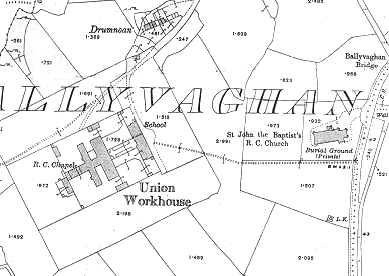
Ballyvaughan workhouse site, 1914.
The layout of the Ballyvaughan workhouse was unusual. It differed in a number of respects from the standard earlier designs found, for example at nearby Ennistymon, but neither did it adopt the typical second wave layout, as seen for example at Kildysart. Ballyvaughan's design was, however, similar to its neighbour at Corofin built in the same year and seems to have been based on that used at Dingle and Castletownbere. A low block at the east contained the porter's lodge, school rooms, probationary wards, and offices. To the rear, the main building was three storeys high which housed the able-bodied at the centre, with the sick and infirm at each end of the block. A central dining hall ran westwards, dividing the male from the female sides. A separate two-storey fever hospital lay at the west of the site.
In 1895, Ballyvaughan was visited by a "commission" from the British Medical Journal investigating conditions in Irish workhouse infirmaries. Their report described the Ballyvaughan workhouse as a litany of "wretchedness, misery, and squalor" with a complete "absence of discipline or control." Nursing was discovered to be practically non-existent. The mortuary was used a dayroom where male inmates were found to be smoking and lounging on the shelves intended for dead bodies. The commission's recommendation was to "shut up the house, dissolve the Board, and place the inmates where at least they will have humane treatment and the ordinary decencies of life." Further details are available in the full report. In response to a parliamentary question on 13th February 1896, the Chief Secretary for Ireland, Gerald Balfour, stated that a Local Government Board inquiry had found that the BMJ's report on Ballyvaughan was "in many important particulars... at variance with the facts." Furthermore, "the state of the institution was in some respects satisfactory, and in other respects unsatisfactory, yet a good deal had been done by the Board of Guardians in the carrying out of improvements."
At the 1901 census, the population of the union was 3,920.
The former workhouse site was closed in around 1923. The site is now a community playing field and only a fragment of the workhouse boundary wall remains.
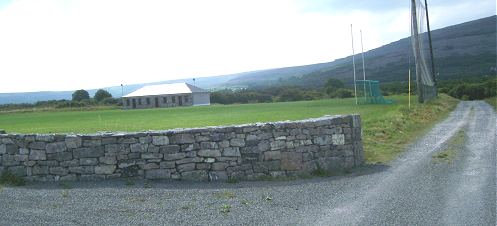
Ballyvaughan workhouse site from the north-east, 2003.
© Peter Higginbotham.
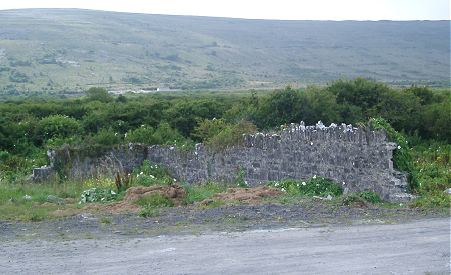
Ballyvaughan workhouse site wall from the south-east, 2003.
© Peter Higginbotham.
At the east of Ballyvaughan lay a presbytery at which workhouse children and some staff are believed to have sometimes been accommodated.
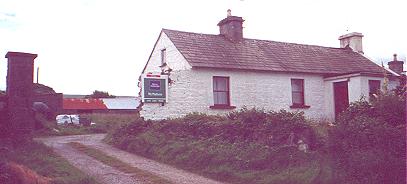
Ballyvaughan presbytery from the north, 2000.
© Peter Higginbotham.

Ballyvaughan presbytery from the north-east, 2000.
© Peter Higginbotham.

Ballyvaughan presbytery from the south, 2000.
© Peter Higginbotham.
The Ballyvaughan Board of Guardians are commemorated in a drinking fountain erected in 1875 as part of an extension to local water works.
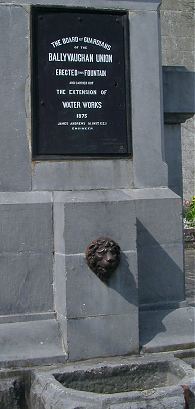
Ballyvaughan water fountain, 2003.
© Peter Higginbotham.
Records
Note: many repositories impose a closure period of up to 100 years for records identifying individuals. Before travelling a long distance, always check that the records you want to consult will be available.
- Clare County Library, The Manse, Harmony Row, Ennis. It is understood, however, that the Ballyvaughan workhouse records have been destroyed.
Bibliography
- Crossman, V (2006) Politics, Pauperism and Power in Late Nineteenth-century Ireland
- Gray, P (2009) The Making of the Irish Poor Law, 1815-43
- O'Connor, J (1995) The Workhouses of Ireland
Links
- None.
Unless otherwise indicated, this page () is copyright Peter Higginbotham. Contents may not be reproduced without permission.


